"In his drawings he flew World War One aircraft, traveled on flying carpets, rode hot air balloons, visited the stars." (Fernando Mendes de Almeida)
“In his drawings he flew World War One aircraft, traveled on flying carpets, rode hot air balloons, visited the stars.” (Fernando Mendes de Almeida)
An aviator. That is was what Sergio wanted to be when he grew up. If for some reason he could not achieve that, he would be a race car driver. He got his taste for speed early on. He was still a young boy, but a great admirer of a friend of his grandmother Stella, Irineu Correia, who was an aviator and a race car fanatic. Another friend of hers, Pedro Correia da Rocha, had a large farm where the family spent many summer vacations. There was a real locomotive on the farm, and Sergio was happy while playing and dreaming of one day being able to fly or to drive the roads in a fast car. There was also a friend of his mother, Elsa, called Dark de Mattos, a millionaire who had boat and a plane and used to take Sergio’s family for rides. The boat was kept at the Rio de Janeiro Yacht Club, and the plane would land nearby there, in a small field. The boy was fascinated: “I think my passion for planes comes from all these things. Dark would do pirouettes and suddenly lower the plane, it was sensational. I loved the smell of gasoline.”
And not even the tragedy he witnessed in 1935 scared him off. A year earlier, in 1934, there was the first Gávea circuit, which he watched with excitement and further enhanced his passion for racing. After all, he kept pace with the history of racing cars ever since he was 6. But the following year, his grandmother’s friend, Irineu Correa, who had a car repair shop, got involved in an accident during the race and died instantly. It was a shock that he never forgot. “I was there, and I think he was the first person I knew who died. I was very impressed with that.” But the passion for race cars and aircraft followed him for life.
He got to know the Correia da Rocha farm, in Cabo Frio, while yet quite young. His parents took him there at age one for him to gain some weight because he was too skinny. His maternal grandmother, Stella Mendes de Almeida Santos, called Sergio a “chick” because he was born thin. And he was so thin that he himself used to say, when looking at his photos, that he looked like a monkey, with huge eyes popping out of his head because he was so skinny. He only left the place when his sister Maria Tereza was born. He was then two years old.
After they got married, Roberto and Elsa moved to Copacabana, near the Cardeal Arcoverde square. But they did not stay at that first home long. Since Mário, Sergio’s paternal grandfather, had a huge house, almost a mansion, at Copacabana as well, at Joaquim Nabuco, 62, the couple eventually moved to Elsa’s father’s house when Sergio was less than a year old. More precisely to a “very nice” habitable basement, as Sergio would say later on as an adult. It was a house full of rooms to house the Rodrigues family, which had 14 children. It was in the basement days that Roberto met Cândido Portinari in college, who would always visit him at Mário’s house. They were such good friends that Roberto invited Portinari to share his painting studio with him. Portinari came to paint several portraits of Roberto, Sergio’s father, and of all the Rodrigues family. When her husband died, Elsa left the Rodrigues house and moved with her mother to another place.
Grandmother Stella was a major influence in Sergio’s upbringing. Stella came from a family of intellectuals. Her grandfather, Candido Mendes de Almeida, was a writer, a professor of geography and history in São Luis do Maranhão, and served as a Senator of the Empire. Stella’s father, Fernando Mendes de Almeida, was a law graduate and a Senator. In 1984, he bought the Jornal do Brasil newspaper.
Once her daughter became a widow of Robert, Stella went ahead and brought in her three grandchildren – Sergio and his sisters, Maria Tereza and Vera Maria, who was still in her mother’s womb – and replaced the Rodrigues family, of artists and journalists, for the Mendes de Almeidas in young Sergio’s life. Mother and children all went to live with their grandmother. Sergio’s maternal great-grandfather, Fernando, was a very wealthy man, but gradually lost his fortune. He actually became the owner of the Jornal do Brasil newspaper in the early twentieth century, but during one of his trips he lost the newspaper to one of his employees, the future Count Ernesto Pereira Carneiro.
Stella had three brothers and a sister and married Portuguese physician Jorge Abranches Santos. She had an only daughter, Elsa, Sergio’s mother. Elsa was a modern woman for her time, full of life. She was born in Paris and, despite having studied at the Sacre-Coeur de Marie Catholic school, she was a free-spirited Rio de Janeiro resident. Intelligent, a lover of life, she spoke several languages. Her family, who had a guaranteed place in the Rio de Janeiro society, lived in a big house at Botafogo Beach, and to go to school the girl used the shortcut between Botafogo and Laranjeiras, which was under construction at the time (today it is Pinheiro Machado street). There was a time when Elsa, while yet a young girl, went to school riding a donkey she was given by her grandfather, Fernando Mendes de Almeida, accompanied by an employee who would go on foot. Sergio used to like to say that all school girls would line up to go for a ride on the donkey.
After the shock at the death of her husband, Elsa needed to unwind. A while later she traveled to Paris, to the house of a diplomat uncle, her mother’s brother, and stayed there for a year. Her children stayed with their grandmother during that time. Sergio was almost three years old then, and because of her absence he had no memories of his mother in his early childhood. First communion, school parties – in his memories, it was the image of grandmother Stella that came to mind when he tried to remember his early childhood.
When she returned from Paris a year later, Elsa moved in with her children and mother Stella in a village, at São Clemente street, next to Colégio Santo Inácio. Sergio had few memories of this house. However, one of the strongest and most wonderful images he kept was that of his mother arriving by ship from Europe, when he went pick her up at the port. Through one of the ship’s portholes, she shook an object in her hand and shouted to her son: “Look what I brought you.” It was a toy car, one of those 1930s race cars, and yet another element of his “amazing connection” with racing cars.
At that time, the family still lived in the village near Santo Inácio. They then moved to the house of uncle James, Stella grandmother’s uncle, where Sergio lived for most of his childhood and adolescence, of which he has the best and most vivid memories, filled with joyful and creative stories that helped shape the artist and inventor.
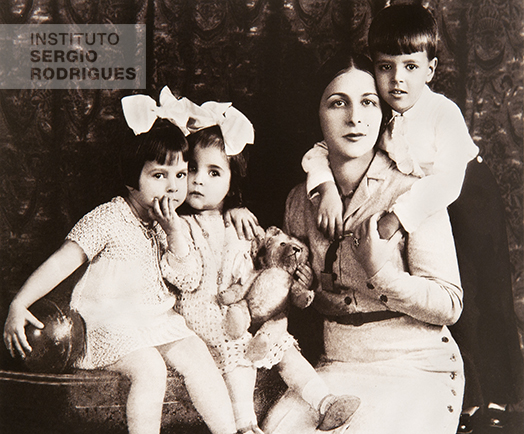
Elsa Fernanda Santos Rodrigues with her kids. From left to right, Maria Thereza, Vera Maria, and Sergio Rodrigues, Rio de Janeiro, 1933.
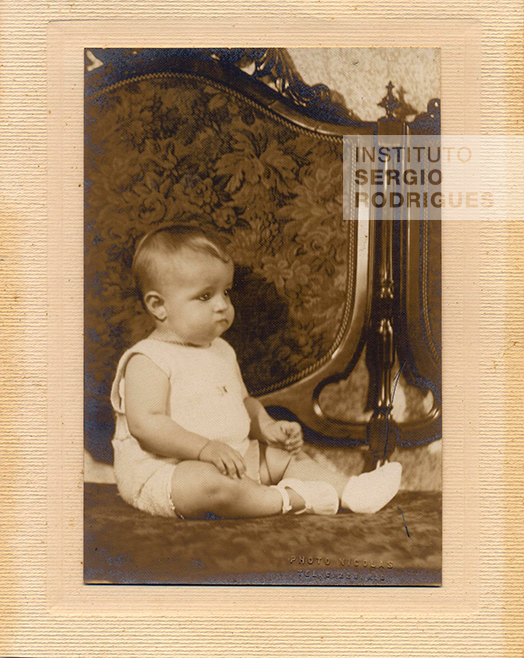
Sergio Rodrigues at age 1, at the Mendes de Almeida family residence, in Rio de Janeiro, in 1928.
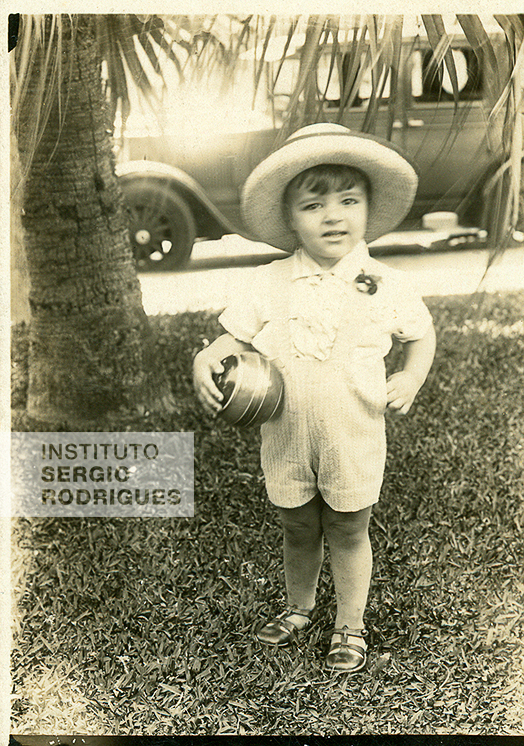
Sergio Rodrigues at age 3, Rio de Janeiro, 1930.
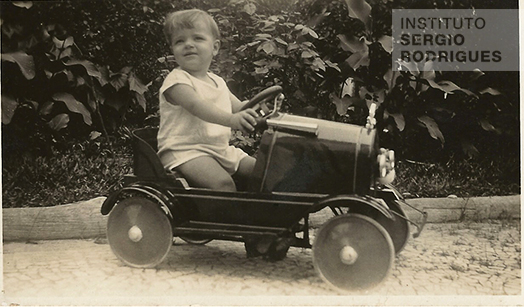
Sergio Rodrigues at approximately age 3 in his baby carriage, in Rio de Janeiro, some time around 1930.
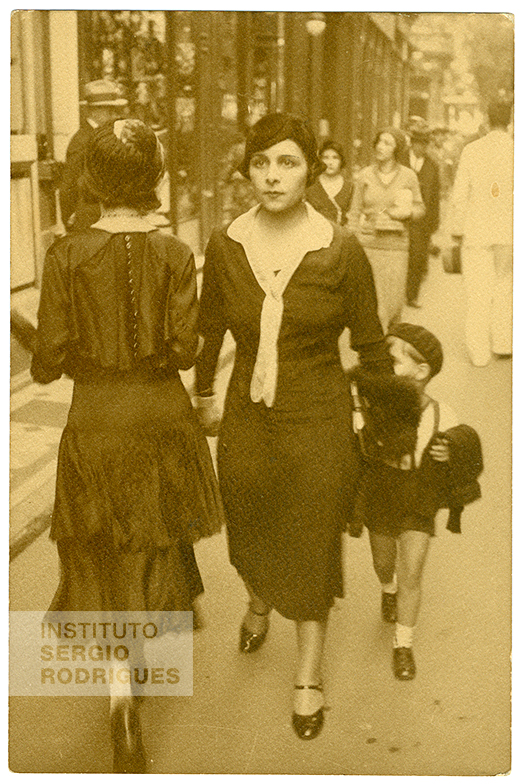
Elsa Fernanda Mendes de Almeida Santos with Sergio Rodrigues, downtown Rio de Janeiro, in the 1930s.
